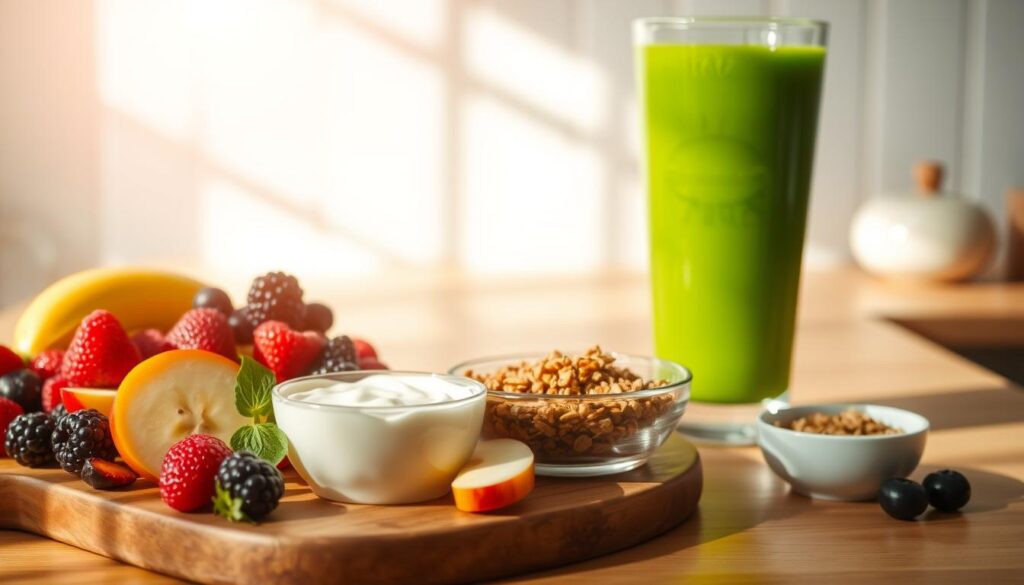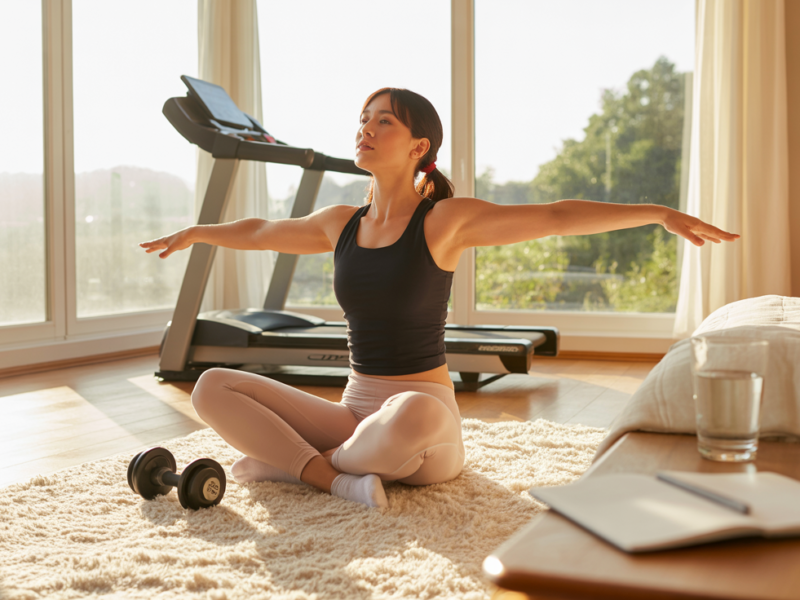Did you know? 92% of successful people have a morning routine. It’s not about emails or social media. Starting your day right shapes your life.
Your morning sets the tone for the day. It’s not about rushing to find socks. What you do before breakfast is more powerful than breakfast itself.
Think of these moments as your daily reset. It’s your chance to get your energy back. By starting your day on purpose, you create it, not just follow it.
We’re exploring seven activities that change your mornings. These aren’t just ideas. They’re science-backed practices for busy people. They help you feel grounded and ready for the day.
No need for complicated routines or expensive stuff. Just simple changes that fit into your life.
Key Takeaways
- Morning routines used by 92% of successful people set the foundation for daily productivity and well-being
- Pre-breakfast activities can be more impactful than breakfast itself in shaping your entire day
- Intentional morning moments help you create your day instead of react to it
- Science-backed morning practices require no special equipment or complicated schedules
- Simple pre-breakfast habits can transform chaotic mornings into grounded, energized starts
Wake Up and Hydrate Your Body
Think of your body as a car that’s been running on empty all night. You wouldn’t start your engine without checking the oil. Your body needs the same care in the morning.
Here’s a simple wake-up ritual: go to the bathroom, splash cold water on your face. Spray rose water on your skin and make warm water with lemon. If you’re feeling sick, try a turmeric ACV elixir with honey instead.
Why Your Body Craves Water After Sleep
Your body worked hard all night, not partying but doing maintenance. Cells were repairing, liver processing toxins, and kidneys filtering waste. All this used up your water.
When you wake up, you’re a bit dehydrated. Your blood is thicker, brain needs fluid, and organs need fuel. Starting with water kickstarts your metabolism and wakes you up.
Water does more than quench thirst. It carries nutrients, lubricates joints, and regulates temperature. It’s like hitting the reset button on your body.
Simple Ways to Make Water More Interesting
Plain water is fine, but sometimes it’s boring. The good news is you can make it more exciting without adding calories or artificial stuff.
Warm water with lemon is a gentle detox and gives you vitamin C. It’s easier on your stomach than cold water in the morning.
Sea salt in your water adds natural electrolytes. This is good if you sweat a lot at night or live in a hot place.
Room temperature water is great if you don’t want to shock your system. Some like ice-cold water, others prefer warm. The key is consistency — always drink water first, not your phone.
These simple tips can change your morning. Your body will thank you for hydrating first.
Stretch or Do Gentle Yoga
After hours of sleep, your muscles feel stiff. It’s time to wake them up and get your blood flowing.
Time to move your body! You might walk or do a 15-20 minute yoga flow on YouTube. Or try a barre-inspired workout.

Benefits of Stretching
Gentle stretching isn’t about being a pretzel. It’s about waking up your muscles and making your joints feel better. Even five minutes of basic stretches can help a lot.
Morning movement makes your brain get more blood. It also makes your body feel less stiff. It helps prevent injuries and genuinely makes you feel more awake and full of energy.
These simple wellness activities don’t have to be perfect. They just need to feel good in your body and match what you need that morning.
Simple Yoga Poses to Start Your Day
Start with basic moves that your body will thank you for. Try gentle cat-cow stretches to wake up your spine. Or simple spinal twists while sitting on the edge of your bed.
Reach your arms overhead and take three deep breaths. This simple move alone can energize your entire system. If you’re feeling more ambitious, a few sun salutations will get your heart pumping gently.
The beauty of morning stretching lies in listening to your body. Some days call for gentle movements, while others might inspire more dynamic wellness activities. Trust what feels right and start there.
Meditate for a Clear Mind
Before your brain gets busy, give it a break. Morning meditation isn’t about being perfect. It’s about making space before life gets busy.
Even three minutes of deep breathing can calm you down. It trains your mind to think before acting. The key is to do it every day, not for a long time.
Techniques for Morning Meditation
Try these easy methods that fit into your morning:
- Guided meditation apps like Headspace or Insight Timer offer easy sessions
- Silent breathing practice—just focus on your breath for 5-10 minutes
- Vedic meditation using silent mantras for deeper focus
- Body scan technique—check in with each part of your body
Find a quiet spot and sit comfortably. If your mind drifts, gently bring it back. Remember, it’s all part of the practice.

How Meditation Reduces Stress
Morning meditation changes your brain for the better. It makes you better at handling stress. You’re building mental resilience for the day.
Studies show meditation lowers stress hormones and makes you feel calmer. You’ll think clearer and handle challenges better.
Doing it daily is better than doing it once a week. Your future self will be grateful. Start tomorrow and give your mind a break.
Journaling to Set Intentions
Starting your day with pen and paper is very powerful. It’s a great self-care practice. Your brain is like a computer with too many tabs open. Journaling helps close the ones you don’t need.
Morning journaling is like a reset button. It turns your thoughts into clear ideas on paper. You don’t have to write a book or make your writing perfect.
Just a few bullet points can help you plan your day. This practice helps you deal with feelings, clear your thoughts, and set a purpose for the day.

The Power of Morning Pages
Morning pages are about writing your thoughts first thing in the morning. It’s a practice started by Julia Cameron. But you don’t need to write three full pages to get benefits.
Writing by hand is special. It helps your brain process information in a different way.
This isn’t about writing perfectly or deeply. It’s about clearing your mind. Many people find it helps them feel calm and focused. It’s a part of their 10-minute morning routine.
Ideas for Your Daily Journal
Not sure what to write? Here are some ideas:
- Three things you’re grateful for — even small things matter
- One thing you’re looking forward to — it could be your morning coffee
- Your top priority for the day — what’s most important?
- How you’re feeling right now — no judgment, just awareness
Some like structured prompts, while others write freely. You might have a latte and use a bullet journal to make a to-do list.
Look back at the day before to see what needs attention. The key is consistency, not perfection. Even five minutes of journaling can be very valuable.
Enjoy a Quick Workout
Movement doesn’t have to be long. A short morning workout can change your day. Just 10-15 minutes can make you feel happy and full of energy for hours.
Quick workouts wake up your muscles and get your blood moving. It’s a simple way to stay healthy and feel good.

Types of Quick Morning Exercises
The best exercises are ones you’ll do every day. Bodyweight exercises are great because they need no equipment and little space.
Try these easy options:
- Yoga flow: Do 15-20 minutes of gentle stretching and movement on a mat
- Barre-inspired moves: Do squats, lunges, and pulses to work big muscles
- HIIT circuit: Do push-ups, squats, and planks for 30-45 seconds each, repeat 2-3 times
- Dance session: Dance to your favorite songs
Choose something you like. Sustainability beats intensity every single time. If it feels like a chore, you won’t keep doing it.
On sweaty days, shower quickly while listening to music. This makes your morning complete and leaves you feeling good.
How Short Workouts Boost Your Mood
Morning exercise boosts your mood more than coffee. Physical activity releases endorphins that make you happy and less stressed.
Short workouts also make your brain work better. You’ll think clearer and feel more awake in the morning.
Working out in the morning feels rewarding. You’ve already done something important before the day starts.
Exercising in the morning means you’ve done it. You won’t have to decide later if you’re tired. This makes it easier to stay active every day.
Plan Your Day
Planning your morning is like setting a GPS for your day. It helps you avoid wandering and instead, follow clear directions. This habit turns random thoughts into focused action.
Just five minutes of planning is better than hours of scrambling. You don’t need fancy tools. Just a clear mind and honest priorities. This makes your morning more energizing.

Creating a Morning Routine
Make your planning routine feel natural. Find a time and place where you can think well. Some like their kitchen table with coffee. Others prefer a quiet spot with natural light.
Keep your tools simple and easy to reach. A notebook works great, just like apps. The most important thing is to be consistent, not complicated. Your routine should take only a few minutes.
Start by looking back at yesterday. What went well? What didn’t? Any unfinished tasks for today? This helps you learn and avoid bad patterns.
Tips for Effective Daily Planning
Focus on your top three priorities for the day. Three is the best number because it’s doable without feeling overwhelmed. More than three can make you feel scattered.
Here are the key parts of good daily planning:
- Review fixed commitments — Check your calendar for meetings and appointments first
- Choose 1-3 important tasks — Pick what truly matters, not just what feels urgent
- Be specific with timing — “Exercise” is vague; “20-minute walk after lunch” is actionable
- Build in buffer time — Things always take longer than expected
- Stay flexible — Your plan should guide you, not imprison you
The goal is to be clear and intentional, not perfect. Your daily plan should help you, not control you. Keep it simple and realistic. This small morning effort will greatly benefit your day.
Eat a Light, Healthy Snack
Your body likes a gentle start in the morning. Sometimes, you need a snack to get you going before breakfast. Think of it as fuel for your morning routine — not a full meal, but a smart energy boost.
A light, healthy snack can stabilize blood sugar levels and stop that hangry feeling. It gives you energy for your wellness practices. Choose foods that nourish you without making you crash.
Best Snacks to Fuel Your Morning
The best morning snacks have protein, healthy fats, or fiber. These give you steady energy without overwhelming you. Here are some quick and nourishing options:
- A handful of almonds or walnuts
- Apple slices with almond butter
- A few dates for natural sweetness
- Greek yogurt with berries
- Half an avocado with sea salt

Avoid heavy or processed foods. They might make you feel slow during your morning. Keep your snack small — you’re not trying to replace breakfast.
How Snacks Affect Your Energy Levels
The right snack before breakfast can improve your workout performance and prevent feeling dizzy. If you exercise in the morning, try a small snack 30 minutes before. This gives you energy without upsetting your stomach.
Your energy levels depend on your body. Some people do better without breakfast. Others need something to get them going.
Listen to your body — there’s no one-size-fits-all answer. Notice how different foods make you feel. What works for your friend might not work for you, and that’s okay.
Review Your Goals
Dreamers and achievers differ by one key morning habit: goal review. Your goals shouldn’t just sit in a forgotten notebook. They need regular check-ins to stay alive and relevant.
Spending a few minutes each morning reviewing your goals keeps them in focus. This doesn’t mean obsessing over every detail. It’s about keeping what matters most to you in mind.
When you regularly connect your daily actions to your vision, you stop drifting. You start moving with purpose.

Setting Short and Long-Term Goals
Smart goal setting looks at both immediate and future goals. Your short-term goals might be what you want to do this week or month. Your long-term goals are about where you want to be in six months or a year.
Here’s how to balance both types of goals:
- Weekly goals: Specific tasks you can complete in 7 days
- Monthly objectives: Bigger projects that need consistent effort
- Quarterly targets: Major milestones that require planning
- Annual vision: Your big picture dreams and aspirations
The key is connecting these different timeframes. Your daily actions should feed into your weekly goals, which support your monthly objectives.
Making a Daily Action Plan
Turning goals into action requires a simple daily planning process. Ask yourself each morning: what’s one small action I can take today that moves me closer to these goals?
Sometimes it’s obvious, like working on a specific project. Other times it’s subtler, like having a difficult conversation or learning something new.
Your daily action plan should include:
- One primary goal-related task: Your main focus for the day
- Two supporting activities: Smaller actions that contribute to progress
- One learning opportunity: Something that builds relevant skills
- Connection points: How today’s work links to bigger objectives
The power lies in the consistency of this practice. These morning habits transform wishful thinking into intentional action, one day at a time.
Spend Time in Nature
Nature is like a reset button for you. It brings calm before your day starts. Just five minutes outside can change your energy and thoughts.
Stepping outside feels good because of science. Fresh air benefits your blood and body. Natural light helps you feel awake and balanced.
Living near trees in a tiny house helps many people feel better. Walking barefoot or standing on grass connects you to the earth.

Benefits of Morning Fresh Air
Your body needs fresh air after sleeping indoors. Breathe deeply outside to fill your body with clean oxygen.
Morning air lowers your stress hormone, cortisol. Being outside calms your nervous system quickly.
Temperature changes outside wake you up. Cool air tells your brain it’s time to be alert.
Incorporating a Nature Walk
You don’t need big outdoor activities to enjoy nature. A simple walk around your block is enough.
City folks can find nature in small places. Open your windows or step onto your balcony. The key is to slow down and notice nature.
Try this: Look at trees, feel the air, and listen for sounds. This practice connects you to the present and reminds you of your place in the world.
Even in apartments, you can connect with nature. Tend to plants, sit by a window, or enjoy coffee outside. The goal is to stay in touch with nature before your day starts.
Connect with Loved Ones
Think about talking to someone who knows your middle name before checking emails. This change can make your day better. A simple hug or “good morning” can mean a lot.
Choosing to connect with others is more important than scrolling online. Text a friend who makes you laugh or call your mom. Being there for others is key.

The Importance of Morning Check-Ins
Your brain wants connection as soon as you wake up. Real talks in the morning make you feel good. It’s science that works.
These morning talks help you face tough days. They remind you of what’s important. These moments of genuine connection make you stronger.
Even if you live alone, you can connect in the morning. Call family or friends regularly. Say hello to your neighbors or coworkers. Your coffee shop barista might become a friend.
Ways to Connect When You’re Busy
Busy mornings don’t mean you can’t connect. Here are easy ways to stay connected:
- Send a voice message while getting dressed
- Share coffee with your partner without phones
- Write a quick note for your family’s lunch boxes
- Call someone during your commute
- Give genuine compliments to people you encounter
Being present is the most important thing. Put away your phone. Look at people. Listen well. Quality trumps quantity every time.
Relationships need daily care to stay strong. Your morning ritual is an investment in your loved ones. Start small, stay consistent, and see how it changes your life.
Limit Technology Use
Your phone might be the biggest saboteur of your morning routine. It sits on your nightstand, ready to grab your attention. Starting your day by scrolling through notifications makes you react instead of plan.
Benefits of a Tech-Free Morning
A digital detox in the morning saves your mental energy. Your brain is most distracted right after sleep. Grabbing your phone first lets others control your mood.
Mindful mornings start with keeping screens away from your bed.
Alternatives to Screen Time in the Morning
Use an old-school alarm clock instead of your phone. Yes, they’re made and work well without distractions. Keep your phone in another room or face-down on your bed.
Use those first minutes for yourself. Stretch, take deep breaths, or think about what you’re thankful for. Check your messages later, after you’ve focused on yourself.
This isn’t about hating technology. It’s about being smart about when and how you use it. Your phone will be there when you’re ready.


